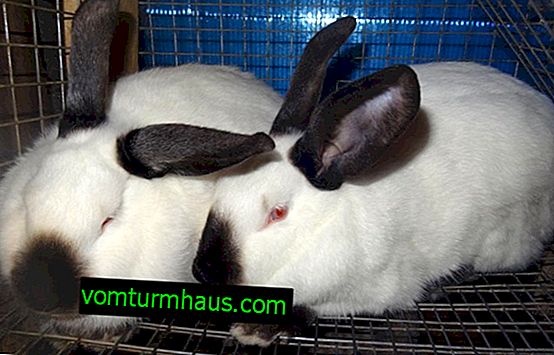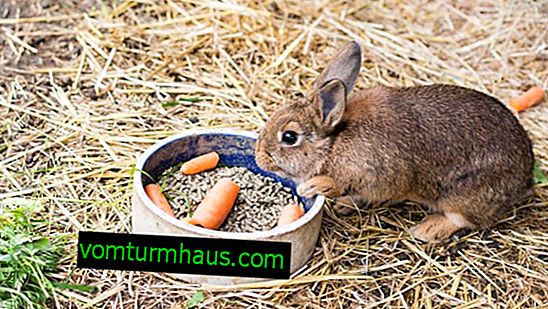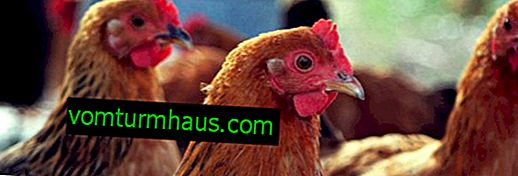What breeds of rabbits are best bred for meat at home
Breeding meat breeds of rabbits is a popular area of rabbit breeding. To get the maximum income from it, you need to select breeds that are easy to maintain and have high productive indicators. They will be discussed in this review.
The best breeds of rabbits for breeding for meat
All variety of breeds was created in two ways:
- naturally due to the transport of rabbits from one region to another;
- cross-breeding using genetic manipulation.

- down rabbits;
- meat;
- skinned;
- meat-skins;
- decorative.
Strokach
An overview of the largest rabbits of meat breeds should begin with a stringer. Another name is the German motley giant. They owe their origin to the Flanders giants. With the help of the flanders, the productive characteristics of the local breed were improved. We advise you to learn more about rabbit breed rabbits and the features of their content. Characteristics of the German motley giant:
- size - large;
- weight - 5-6 kg;
- life expectancy - 12 years;
- dense muscular body;
- medium-sized head on a short thick neck;
- ears are large, long (15 cm);
- powerful paws.

The rabbit is very obedient and does not create problems for the breeder. A characteristic feature of the breed is that the stringer is easily frightened and can bite or scratch the source of fright. The German motley giant is susceptible to certain intestinal parasitic or bacterial infections, especially when malnourished. Also, the stringers are prone to spinal pathologies.
Important! Any disturbance in the rabbit’s musculoskeletal system is a lack of vitamin D and minerals. To fill their deficit will help you bran, animal feed and sprouted grain.
White pannon
White pannon bred in Hungary and is a hybrid of three other breeds: New Zealand white, California rabbit and white giant. This beautiful beast is bred for meat and fur.
White Pannon Feature:
- size - large;
- weight - 5 kg;
- life expectancy - 10-12 years;
- large pear-shaped head;
- ears are large, thick, of medium length;
- short thick neck;
- long elongated body;
- strong paws.














Color - exclusively white. White pannon is considered a fairly strong and hardy breed. They have a great temperament and a wonderful eye. Pannons are considered one of the most promising breeds due to the large number of spouts (6-7) and rabbits in one litter (up to 9). These rabbits are ill little and live long.
Flanders
Flanders or the Belgian giant is the largest breed. Individual representatives weigh about 10 kg, and the maximum recorded weight is 25 kg. Flanders became the unspoken foundation for breeding other breeds.
Characteristics of flanders:
- size - large;
- weight - 10-12 kg;
- life expectancy - 10 years;
- large head shape;
- ears are large, straight;
- long elongated body;
- strong paws.

California
Another very popular meat breed is Californian. This is the result of multiple crosses of New Zealanders, chinchillas and Himalayan rabbits. They are the fastest growing rabbits. The aim of the selection was to obtain a breed with high-quality fur and improved early maturity. Californians are valued for their versatility and truly possess excellent quality meat and fur. Learn more about breeding and keeping California rabbits. Californians Feature:
- size - large;
- weight - 5.5 kg;
- life expectancy is 8–10 years;
- big head;
- long ears;
- thick short neck;
- cylindrical body;
- thick glossy fur;
- strong paws.

A distinctive feature is the fur of Californians: white with black dots on the ears, nose and legs. Productive qualities of the breed are also at a high level. A Californian female can bring up to 35 rabbits per year. Excellent character allows you to get them as pets.
Gray giant
This beautiful breed, bred by Soviet breeders in the 1950s. The modern gray giant is grown as a representative of the meat direction, but when breeding it belonged to the meat-and-peel direction. The ancestors were flanders and ordinary outbred rabbits from Poltava. Did you know? In the mythology of many peoples of the world, rabbits are a symbol of fertility and fertility. And indeed it is. After all, one couple in 4 years can become the ancestors of 4 million new animals. Gray Giant Feature:
- size - large;
- weight - 4.5–7.5 kg;
- life expectancy - 10 years;
- big head;
- thick short neck;
- elongated rounded trunk;
- powerful paws.












White giant
The white giant was obtained by German and Belgian breeders in the 20th century as a result of crossing chinchillas and albino flanders. The purpose of selection is to obtain an exclusively white skin without yellowness and interspersed with a different color.
Read more

White Giant Feature:
- size - large;
- weight - 4.8–5.8 kg;
- life expectancy is 8–10 years;
- big head;
- large straight ears;
- powerful neck;
- elongated stocky body;
- rounded croup;
- straight back.
The skin color is pure white. The fur is 4 cm long. The animal is characterized by a peaceful, accommodating character. The female makes big litters. They can have 5 to 9 babies.

Soviet chinchilla
Soviet chinchilla obtained by crossing a white giant and a European chinchilla. The first - representatives of the meat industry, the second - skins. As a result of crossing, excellent meat rabbits with a deep sternum and a powerful body were obtained. Adults can be quite large. Important! Rabbit hair consists of protein compounds. To maintain it in excellent condition - include protein foods in your pet's diet. Characteristics of the Soviet chinchilla:
- size - large;
- weight - 5-6 kg;
- life expectancy is 10 years;
- powerful neck;
- medium erect ears;
- small head;
- elongated rounded trunk;
- straight back.

New Zealand Red
New Zealand Red is a breed of American origin. It is extremely popular and is the base for breeding other breeds. New Zealanders are bred to get meat, skins, participate in exhibitions and even as pets. They quickly gain weight with a good ratio of meat and bone. We advise you to learn more about the New Zealand rabbit breed. New Zealand Red Feature:
- size - large;
- weight - 5-6 kg;
- life expectancy is 8–10 years;
- large neck;
- long large ears;
- proportional head;
- muscular body;
- the presence of a breast in females;
- strong paws.














Burgundy
The Burgundy rabbit was obtained in the same region of France at the beginning of the last century as a result of crossing New Zealand Reds and Californians. This beautiful beast was bred for meat and fur. Burgundian is a great rabbit for beginners, due to its resistance to disease. Did you know? People and rabbits react equally to illnesses. Therefore, furry animals are participants in the development of drugs for diabetes, tuberculosis and other diseases. And most often New Zealand rabbits play this role. Burgundian characteristic:
- size - medium;
- weight - 4–4.5 kg;
- life expectancy is 8–10 years;
- powerful roundish body;
- small paws;
- rounded croup.

What is fed to rabbits of meat breeds: the right diet
The level of metabolism of meat breeds requires more food and more careful adherence to the diet. An important component of the diet is hay, roughage, which reduces the likelihood of malocclusion or digestive problems. Grass hay harvested from meadow grasses will be more preferable than other types of hay.
Green leafy vegetables are also important in the diet. Their volume is about 200 g per day. You can offer your pet goodies in the form of carrots and apples, but there should be few because of the high sugar content in the product.
From vegetables and greens, the diet includes:
- salad;
- escalope;
- turnip;
- cabbage;
- parsley;
- thyme;
- cilantro;
- dandelion.

The tops of radishes and carrots are also excellent sources of nutrients, but should be given sparingly due to their high calcium content. New vegetables are introduced gradually so as not to disturb digestion. Corn and potatoes are not given to rabbits because of their high starch content.
Daily Values:
| Feed type | Winter diet (in g) | Summer diet (in g) |
| concentrated feed | 150-200 | 120-150 |
| meadow hay | 250 | 180-200 |
| young tree branches | 80-100 | one hundred |
| leafy greens | 300 | - |
| root vegetables and vegetables | 150-200 | 150 |
| greenery | - | 700 |
Breeding rabbits is a fairly profitable business. The early maturity of most of these varieties is 3-4 months. The offspring of one female per year is 30–35 babies. If you follow the technology of feeding and the correct selection of breeds - you can easily achieve high rates of profitability.





